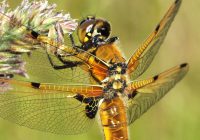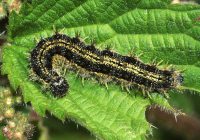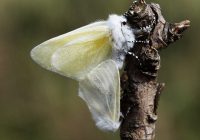Dr Phil Smith’s Wildlife Notes
June 2013
Unexpectedly for this record-breaking year, June turned out to be a relatively “normal” month, with warm sunny conditions for the first ten days, followed by a mix of rainy and fine days. Nevertheless, the first appearances of many plants and animals continued to be much delayed. Having not seen a single dragonfly in May, it was reassuring on the first day of June to find a big hatch of Four-spotted Chasers with Azure and Blue-tailed Damselflies on Birkdale Green Beach. The first Common Blue butterfly of the summer, was also there, while over the next few days plenty of Small Heaths and even a scatter of the increasingly rare Wall Brown appeared in the dunes. Broad-bodied Chasers were widespread along the coast, a handsome female posing for photographs at Ainsdale Sand Dunes NNR’s Pinfold Pond on 4th, while six Crossbills flew overhead calling.
Continuing the dragonfly theme, a short visit to Downholland Book at Alt Bridge on 7th provided good views of several spectacular Banded Demoiselles, while numerous Small Tortoishell caterpillars on nettles was better news for this sadly declining, previously common, butterfly.
However, the insect highlight of June was the now regular appearance of thousands of White Satin moths at Ainsdale Sandhills Local Nature Reserve. There was concern that the deep flooding of the slacks would have killed off young caterpillars over-wintering on Creeping Willow but enough survived to produce a blizzard of moths, albeit three weeks later than last year. It was a thrilling experience on 21st to see such spectacular numbers of what is a relatively uncommon creature; everywhere, startlingly white adults were emerging from their pupae, females being tracked down by eager males as soon as they appeared, the clatter of a myriad of wings being easily audible over the rustle of vegetation in the gentle breeze. Nearby scrapes produced the first immature Common Darters of the summer and an enormous male Emperor dragonfly. Floral interest was contributed by numerous Bee Orchids and three species of marsh-orchid.
As usual, I led several guided walks organised by the Sefton Coast Landscape Partnership Project and various societies. Altcar Rifle Range attracted over 30 people on 11th to see record numbers of Green-winged Orchids at their premier northwest England locality. Steve Cross had already counted over 26,000 but still had more to add. A wide variety of other interesting plants included many Northern Marsh-orchids, Twayblades and the strange Adder’s-tongue Fern.
From much further afield, the Bradford Botany Group was impressed by the range of rarities on offer at Birkdale & Ainsdale Sandhills Local Nature Reserve on 22nd. The Baltic Rush was seen at its only English site, while Sharp Club-rush occurs nowhere else in Britain. Members logged around 150 different plants during the day, many of them regionally or nationally notable.
Following up a report by vice-county plant recorder, Dave Earl, Patricia Lockwood and I visited the boundary of Woodvale Airfield next to the A565 to see a previously unknown colony of thousands of Shepherd’s-cress (Teesdalia nudicaulis), one of the most rapidly declining plants in the country. A small population on Ainsdale NNR was thought to be the last remaining in South Lancashire, so this represented a major find. Growing with it was Smith’s Pepperwort, a species I hadn’t seen for years, while the road edge was lined by Sea Fern-grass, its presence reflecting winter salt applications.
On 29th, I returned with Trevor Davenport to the site of the large fire at Cabin Hill/Ravenmeols. Three months regrowth had resulted in almost complete recovery of the vegetation. I spotted a Common Lizard, while the presence of at least five fast-flying Dark Green Fritillaries and large numbers of Pyramidal Orchids was encouraging. Parts of Devil’s Hole were still flooded and we were delighted to find hundreds of mature Natterjack Toad tadpoles, while several Northern Dune Tiger Beetles, including two pairs, were active or the surrounding bare sand.




